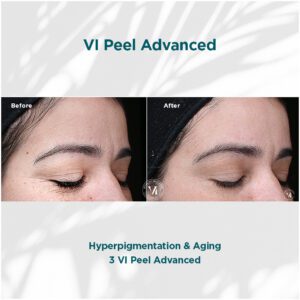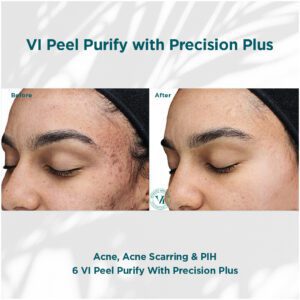What is it? How does it work? Is it for everyone?
We went to the experts on chemical peels at the VI Institute…
And got all of our questions answered.
What is a chemical peel?
A chemical peel is the application of a solution, such as alpha hydroxy acid, beta hydroxy acid or trichloroacetic acid. They range in intensity from low-grade (or light) with minimal downtime to aggressive (or deep). The lighter the chemical peel, the more frequently they can be performed. The more aggressive, the more side effects and length of recovery time one can expect, though the reward may be greater.
How do chemical peels work?
A chemical peel stimulates exfoliation to remove the outermost layers of skin. Our skin exfoliates naturally (in fact, you’re shedding a ton of old skin cells as you read this), but as we age, that exfoliation process (aka, cell turnover) slows and old cells are slower to fall away. Exfoliation instigates your body’s cell turnover process to encourage new cells to the surface, and those cells are fresher, plumper, and help give skin a noticeable smoothness.

What skin type are chemical peels best for?
A chemical peel is best suited for helping skin shed stubborn discoloration, hyperpigmentation, uneven skin tone, and post-acne scarring, as well as stimulating new collagen production. Chemical peels can help with the look of wrinkles, as they lift away dead skin cells that can make a wrinkle look more intense. Though a chemical peel may not completely resolve sagging skin issues, it can help tighten the look of skin due to new collagen production.
What are some potential chemical peel side effects?
Chemical peel side effects can include anything from flushing during treatment to sustained redness after the treatment, swelling, crusting, and peeling. (NEVER pick scabs or skin that begins peeling, as this could cause intense pain and permanent skin damage.) A chemical peel for darker skin tones may experience darkening or lightening of the skin, which is why a chemical peel should only be performed by a dermatological professional who has a thorough understanding of skin care products and the Fitzpatrick skin types. In addition, you can opt to get a chemical peel that is proven safe and effective for darker skin tones, like the VI Peel, the world’s first painless and skin tone inclusive medium-depth chemical peel.
How Many Times A Year Can I Have A VI Peel?
If a series is recommended, the VI Peel is suitable to receive every 4-6 weeks as directed by your Practitioner. Your Practitioner will be able to create your own unique skin care plan for your skincare needs. You can also have the VI Peels quarterly/seasonally and receive 4 peels a year for the maintenance of healthy skin.
How Many Peels Do I Need To Start Seeing Results?
Everyone’s skin is a little different, and the number of peels needed for desired results varies from person to person, and from skin condition to skin condition. While just a single peel will achieve significant skin rejuvenation (think less pigment, smoother skin texture, and brighter, glowier skin overall), in general, we recommend a series of 3-6 peels for optimal results. Make sure to consult with your healthcare professional to find a VI Peel treatment frequency that’s right for you.
Does The VI Peel Burn?
The VI Peel does not burn! You may experience slight warmness and tingling in the beginning, but this should quickly subside. Besides the warmness and tingling, VI Peel treatments are virtually painless.
Is The VI Peel Safe For Darker Skin?
Yes! ALL VI Peel treatments are safe and effective for ALL skin tones. Inclusivity is central to our brand and mission, and all Vitality Institute products are created for and with skin of color in mind.

What Will I Look Like Right After The Peel?
Immediately after the peel, your skin may look slightly tan and glowy. You will not look much different and should be okay going about your regular daily routine.
How Long Will I Peel?
In general, you can expect to start peeling on or around day three and peel for about three to four days afterward. Each person’s peeling experience is a little different, and some may peel for more or fewer days, depending on the condition of the skin. If this is your first VI Peel, it’s also normal to peel for a longer period of time.
Can I Wear Makeup After A VI Peel?
After the VI Peel solution is applied to the skin, no makeup or any topical products can be applied for the first 4 hours, including sunscreen! At the 4 hour mark, you can apply makeup after you’ve completed the “Four Hour Post Treatment” steps.

What’s the best post-treatment aftercare routine for chemical peels?
- Soothe, soothe, soothe! Ask your dermatologist to recommend a professional-grade, super-soothing balm with 1% Hydrocortisone and anti-inflammatory ingredients like Ginger Extract, as well as hydrating ingredients like Glycerin for soothing skin irritation. Our top pick? VI Derm Post-Treatment Repair Cream that’s not only within your skin care budget, but is proven to visibly reduce redness and blotchiness in 2 days.*
- We can’t say it enough: SPF is your BFF. Your barrier is trying to renew itself and needs all the defense it can get against damaging UV light. Reach for a gentle, hydrating medical-grade SPF, like VI Derm SPF 50 Daily UV Defense Broad Spectrum Sunscreen.
- Follow a gentle skin care routine that includes fragrance free cleansers and moisturizers. Wash your face with cool water, not hot, as it can help with soothing skin irritation and tempering redness.
- Moisturize. A chemical peel can be drying, and moisture will help keep skin balanced. Moisturizing can also help comfort and soothe during the reparative peeling stage.
- Don’t do anything that builds heat in the body, from steam rooms to intense exercise.
- Don’t exfoliate.
- Reach out to your dermatologist if you have any issues, concerns, or pain.
References for this article:
*Based on a 3rd party study of Bisabolol and Zingiber Officinale (Ginger) Root Extract on skin irritation.
https://www.mayoclinic.org/tests-procedures/chemical-peel/about/pac-20393473
https://www.mayoclinic.org/tests-procedures/chemical-peel/about/pac-20393473
